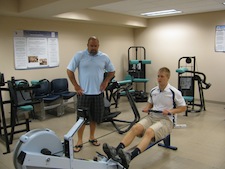Eight University Students Received President’s Fellowships for Summer Research

Eight University students received President’s Fellowship for Summer Research Awards for 2013. The fellowship is a mentorship program that allows students to participate in research under the guidance of a faculty mentor. The awards are given to promising students who faculty members believe possess the ability to handle challenging, real-world research workloads during the summer months.
The research of Paul Pearson of Honesdale and his faculty mentor Argyrios Varonides, Ph.D., professor of physics and engineering, concerns the field of photovoltaics, which is a substantial branch of green energy.
“We are studying the physics of several designs of solar cells that could be candidates for high collection efficiency,” Dr. Varonides said.
Their research project, titled “Higher Efficiency AlAs/GaInP/GaAs p-i-n solar cells, via Tuned GaAs-Ge multi-layers embedded in the intrinsic region: A paradigm for quantum photovoltaics,” attempts to increase the standard of conversion efficiency in solar panels by increasing the absorption of light outside of the visible spectrum.
Dr. Varonides noted that the summer research project is a part of an ongoing effort that applies modern computational techniques and quantum theory to address the central problem concerning photovoltaics today, which is to increase the light collection efficiency of above 45 percent and to reach 50 percent by 2020.
Pearson, a physics major with a minor in mathematics, will graduate in 2014.
Alex Barbolish of Nicholson, a history major at the University, and faculty mentor Kathryn Meier, Ph.D., former assistant professor of history, researched an often overlooked Civil War general.
“Our project is a biography of General Jubal Early who was a confederate general during the Civil War,” Barbolish said. “The Civil War is such a complex event in American history. The biography will help us understand and address the issues that have continued to face our country since the war ended.”
Despite his key role in the war, Barbolish described General Early as having been “forgotten about in mainstream history.” He and Dr. Meier studied documents from several archives from around the country to compose the biography. Barbolish will graduate in 2014.
Scott Holdren of Danville and faculty mentor David Rusak, Ph.D., professor of analytical chemistry, researched “Trace Elemental Analysis of Human Hair.” For this project, they separated the inner and outer layers of individual hairs by dissolving them in acid. From there, they compared the elemental composition of the different layers using state-of-the art equipment in the University’s Loyola Science Center, including an atomic absorption spectrometer, to analyze the chemical make up of the hair. The purpose of the analysis is to determine deficiencies of certain elements in the hair in the hopes of linking those deficiencies to the presence of, or predisposition to, diseases in humans. Holdren is a chemistry major with a minor in Spanish and mathematics who will graduate in 2014.
Emily Harasym of Factoryville and faculty mentor George Gomez, Ph.D., associate professor of biology, researched “The Effects of Retinoic Acid on Neuroblastoma Growth and Differentiation.” For this project, they introduced retinoic acid, a vitamin A derivative, to neuroblastoma cells in the hopes of inhibiting tumor growth. Neuroblastoma is one of the most prevalent cancers in infants and children. They hope their research will allow for a better understanding of the mechanisms of cancer cell metabolism. Harasym, a biochemistry, cell and molecular biology major, will graduate in 2015.
The research of Dustin Frisbie of Dalton and faculty mentor Declan Mulhall, Ph.D., associate professor of physics, is titled “Determining the Spectral Statistics of Randomly Interacting Nuclear Bosons.” They used computers to simulate sub-atomic particle interactions and look for patterns that may help physicists better understand the physical world. Frisbie is physics major with minors in mathematics and computer science. He will graduate in 2015.
Martha Triano of Scranton and faculty mentor Jessica Nolan, Ph.D., associate professor of psychology, researched “Heuristics and Social Norms: A Potential Interaction in Recycling Behavior.” They designed a social experiment to test the social psychology effect of the longevity effect. Triano is a double major in psychology and philosophy. She will graduate in 2014.
Michael Sayad of Little Falls, N.J., and faculty mentor John Deak, Ph.D., associate professor of physical chemistry, researched “The Effectiveness of Cyclomethicones as Chemical Permeation Enhancers for Transdermal Drug Delivery (TDD).” TDD has several advantages over other forms of drug delivery, but is limited in its use by the poor ability of most medicines to penetrate skin’s outer layer. Sayad and Dr. Deak are researching the effect of certain compounds to improve skin permeability to medicines in order to make TDD more useful. Sayad, a biology major in the premedical track, will graduate in 2014.
Stephen Gadomski of Laflin and faculty mentor Paul Cutrufello, Ph.D., assistant professor in the Department of Exercise Science and Sport, studied “An Evaluation of Muscle Imbalance and the Presence of Upper and Lower Crossed Syndromes in Power Lifters.” Their research used human subjects to compare the relative strength of different muscles in the body. They then compared the data gathered from power lifters with at least four years of experience with data gathered from individuals with no training experience. They hope this data will help detect and predict the presence of upper and lower crossed syndromes in power lifters, which can affect the alignment and mobility of joints throughout the body. Gadomski is an exercise science major who will graduate in 2015.






